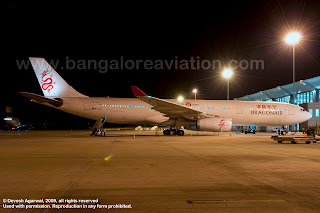by Devesh Agarwal
Ahead of the first flight of the Airbus A350 XWB a set of videos from Airbus which gives us behind the scenes explanations on some aspects of the aircraft design, development, testing, manufacturing, and hand-over to the flight testing crew who will fly the aircraft today.
Like the Boeing 787, the A350 XWB heavily relies on composite materials to lighten the airplane. This video explains the use of composites in the A350. It is largely in French so you will have to follow the sub-titles.
The Final Assembly Line (FAL) is where all A350 airframes are built including the MSN (Manufacturer's Serial Number) 5000 series which were used for static testing on the ground, and MSN001 which will fly later today, god willing, weather permitting.
Prior to any form of flight, the airframe is tortured using special static testing rigs. Observe how the wing is flexed to a deflection of over 5.3 metres (17.38 ft), that is almost two floors of a building.
The first flyable prototype MSN001 is fitted with the Rolls Royce Trent XWB engines, the most powerful engine mounted on any Airbus airframe till date. Even more powerful than the Trent 900 engines on the A380; but then the A380 is powered by four engines, while the A350 is a twin jet.
The A350 XWB MSN001 is painted for flight.
After the first flyable prototype MSN001 is assembled, the manufacturing team turns the aircraft over to the flight test team, which accepts responsibility of the aircraft on behalf of the Engineering Division at Airbus. The flight test team then readies the aircraft and tests prior to the first flight.
MSN001 does not contain much of a passenger cabin. It is filled with mountains of test equipment.
The engines on MSN001 are powered up for the first time.
Fernando Alonso, who shares his name with the world champion Formula 1 Ferrari driver, joined Airbus in 1982 and is the head of Airbus Flight and Integration Test Centre. He will lead the flight test activities for Airbus.
Watch the A350 XWB first flight live.
Ahead of the first flight of the Airbus A350 XWB a set of videos from Airbus which gives us behind the scenes explanations on some aspects of the aircraft design, development, testing, manufacturing, and hand-over to the flight testing crew who will fly the aircraft today.
Like the Boeing 787, the A350 XWB heavily relies on composite materials to lighten the airplane. This video explains the use of composites in the A350. It is largely in French so you will have to follow the sub-titles.
The Final Assembly Line (FAL) is where all A350 airframes are built including the MSN (Manufacturer's Serial Number) 5000 series which were used for static testing on the ground, and MSN001 which will fly later today, god willing, weather permitting.
Prior to any form of flight, the airframe is tortured using special static testing rigs. Observe how the wing is flexed to a deflection of over 5.3 metres (17.38 ft), that is almost two floors of a building.
The first flyable prototype MSN001 is fitted with the Rolls Royce Trent XWB engines, the most powerful engine mounted on any Airbus airframe till date. Even more powerful than the Trent 900 engines on the A380; but then the A380 is powered by four engines, while the A350 is a twin jet.
The A350 XWB MSN001 is painted for flight.
After the first flyable prototype MSN001 is assembled, the manufacturing team turns the aircraft over to the flight test team, which accepts responsibility of the aircraft on behalf of the Engineering Division at Airbus. The flight test team then readies the aircraft and tests prior to the first flight.
MSN001 does not contain much of a passenger cabin. It is filled with mountains of test equipment.
The engines on MSN001 are powered up for the first time.
Fernando Alonso, who shares his name with the world champion Formula 1 Ferrari driver, joined Airbus in 1982 and is the head of Airbus Flight and Integration Test Centre. He will lead the flight test activities for Airbus.
Watch the A350 XWB first flight live.
















































